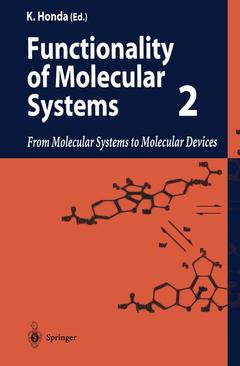Description
Functionality of Molecular Systems, Softcover reprint of the original 1st ed. 1999
Volume 2: From Molecular Systems to Molecular Devices
Coordinator: Honda Kenichi
Language: English
Subjects for Functionality of Molecular Systems:
Keywords
Langmuir; energy; information; molecule; particles; polymer; system; thin films
Publication date: 04-2012
246 p. · 15.5x23.5 cm · Paperback
246 p. · 15.5x23.5 cm · Paperback
Description
/li>Contents
/li>
Molecular systems are assemblies of molecules designed to possess special qualities and desired functionality. Such systems are important because they provide materials with novel properties, and they will be particularly useful for minimizing electronic devices. In this two volume work, the first volume, subtitled 'From Molecules to Molecular Systems', covered the fundamentals of molecular design, while volume 2 deals with the potential applications of molecular systems. Information transduction and energy conversion are the basis of any practical device, and these considerations, along with the required interconnections and interfaces, are analyzed to produce the architectural design for a molecular system. The preparation of molecular systems is also considered, including that of self-organizing molecular assemblies, ultrathin films, and ultrafine particles.
1. Concept of a Molecular System, Molecular Unit, and Molecular Material.- 2. Architectural Design and Preparation of Molecular Systems.- 2.1 Functional Polymers.- 2.1.1 Electron-Conducting Polymers.- 2.1.2 Ion-Conducting Polymers.- References.- 2.2 Organized Molecular Assemblies.- 2.2.1 Bilayer Membranes.- 2.2.2 Langmuir-Blodgett (LB) Membranes.- References.- 2.3 Specially Prepared Molecular Systems.- 2.3.1 Ultrathin Films.- 2.3.2 Ultrafine Particles.- 2.3.3 STM of Adsorbed Molecules.- References.- 3. Molecular Systems and Their Applications to Information Transduction.- 3.1 Electroactive Molecular Systems.- 3.1.1 Electrochromic Molecules.- 3.1.2 Electroluminescent Systems.- References.- 3.2 Photoactive Molecular Systems.- 3.2.1 Photochromic Molecules.- 3.2.2 Photochemical Hole Burning.- 3.2.3 Nonlinear Optics.- 3.2.4 Optical Computers (Molecular Processors).- References.- 3.3 Chemoactive Molecular Systems.- 3.3.1 Integrated Molecular Systems for Biosensing.- 3.3.2 Chemiluminescence.- References.- 4. Molecular Systems and Their Applications to Energy Conversion.- 4.1 Photoactive Molecular Systems.- 4.1.1 Molecular Systems in Biological Photoreceptors.- 4.1.2 Artificial Molecular Systems of Photoinduced Energy Conversion.- References.- 4.2 Photoelectrochemical Conversion.- 4.2.1 Photoelectrochemical Conversion of Solar Energy.- 4.2.2 Photoelectrochemical Reduction of CO2.- 4.2.3 Photocatalytic Decomposition of Air and Water Pollutants.- 4.2.4 Concluding Remarks.- References.- 4.3 Mechanoactive Molecular Systems.- 4.3.1 Thermomechanical Effect.- 4.3.2 Chemomechanical Effect.- 4.3.3 Photomechanical Effect.- References.- 5. Molecular Devices and Molecular Systems—Present Status and the Future.- References.
© 2024 LAVOISIER S.A.S.




